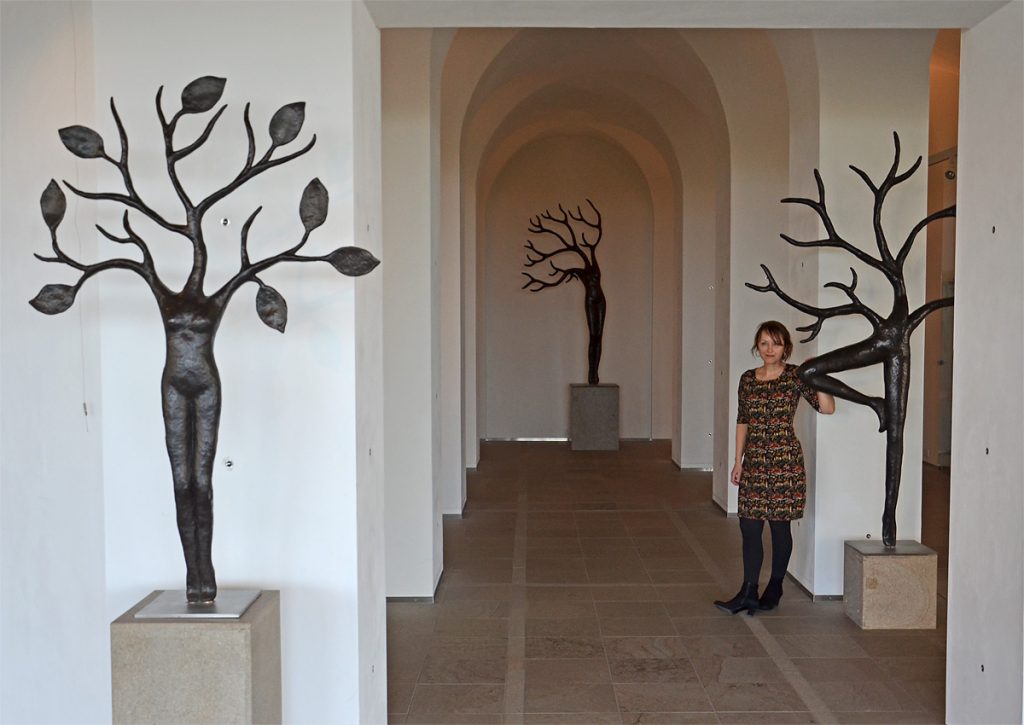Afgelopen voorjaar, toen ik op de patio van museum Beelden aan Zee de pas geplaatste sculptuur van Catinka Kersten bekeek, viel mijn oog op het beeld Daphne van Iris Le Rütte. Een vrouw die in plaats van een hoofd en armen takken naar de hemel strekte. Het is een scène uit de Metamorfosen van Ovidius: de nimf Daphne, op de vlucht voor de verliefde god Apollo, verandert in een laurierboom. De god heeft het nakijken en vlecht een krans van laurierblad – de lauwerkrans.
Later die middag reed ik per auto door een straat met bomen aan weerskanten. Oude bomen met een geschiedenis en jonge aanplantboompjes, allen nog zonder blad. En uit mijn ooghoek zag ik overal om mij heen betoverde nimfen hun takken uitstrekken.
Kijken door andermans oog
Nu is het najaar en ik zit naast Iris Le Rütte op een door haar ontworpen bank in museum Beelden aan Zee, waar één van de vier wintertentoonstellingen aan haar werk gewijd is. Le Rütte (1960) is bekend van haar sculpturen voor prijzen en vooral van haar werken in de openbare ruimte. Dat varieert van drie enorme dromedarissen op een spoorwegviaduct tot een door twee handen opgehouden ‘zwevende’, bronzen draperie, waarop je als op een bank kunt zitten. Vaak wekken de beelden een vervreemdend, weemoedig gevoel op.
Ze is blij als ik haar mijn ervaring met Daphne vertel. ‘Dat is precies wat ik beoog – dat je door het kijken naar kunst meer gaat zien in de buitenwereld, dat je er door andermans oog naar kijkt.’ In de tentoonstelling krijgt deze gedachte ook concreet vorm doordat enkele van haar gedichten en tekeningen op de glazen ruiten zijn aangebracht – een filter voor het uitzicht op de terrassen en de zee.
Beeld aan Zeester
De gezamenlijke geschiedenis van Le Rütte en Beelden aan Zee begint jaren terug met haar brief aan de oprichter van het museum, verzamelaar Theo Scholten. ‘Ik schreef hem dat ik het museum zo mooi vond. Hij reageerde; het bleek dat één van mijn eerste werken voor de openbare ruimte in zijn geboortedorp stond. Toen is directeur Jan Teeuwisse naar mijn atelier gekomen en die heeft een werk van me aangekocht.’
Het leidde tot inmiddels twee solotentoonstellingen en een tweede aankoop, de Daphne. Ook voor Beelden aan Zee maakte Le Rütte enkele kleine sculptuurtjes, waaronder de Beeld aan Zeester, een cadeautje voor de vele vrijwilligers bij het vijftienjarig bestaan. ‘Het zijn drie zeesterren met elk vijf armen. Zo kon ik die vijftien weergeven zonder er een getal op te zetten.’ Sponsors van het museum krijgen een beeldje van een hand met een ginkgoblad, symbool voor de eeuwigheid.

Variaties op de Daphne spelen een grote rol in deze tweede tentoonstelling, Schaduwplaats genaamd. Vrouwen/bomen in verschillende vormen en afmetingen en met verschillende titels moeten een ‘mythisch bos’ vormen in een gewelfachtige ruimte in het museum, dat ingegraven ligt in het Scheveningse duin. Le Rütte: ‘Ik ben heel blij dat het museum mij de kans biedt om te laten zien hoe mijn ontwikkeling sinds de eerste tentoonstelling verder is gegaan.’
Ze verbeeldde meer metamorfosen, zoals die van de jager Actaeon, die door de godin Diana in een hert veranderd werd omdat hij haar had zien baden. Zijn eigen honden herkenden hem niet meer en verscheurden hem. De fascinatie voor Ovidius ligt voor de hand: ‘Mijn werk bestaat heel vaak uit twee delen die in elkaar overgaan: ding in dier, mens in boom… ik wil ermee laten zien dat alles bij elkaar hoort en in elkaar over kan gaan. Het is ook een beetje het oude idee van Aristoteles, dat alles tot stof vergaat en dan terugkomt, opgebouwd kan worden tot iets nieuws. Het gaat bij mij altijd om vergankelijkheid en liefde, noodlot, het onbereikbare. Het is voor kunstenaars vaak een strijd om het vanitas-thema niet clichématig weer te geven. Hoe zorg je dat je niet vervalt in alleen de symboliek van skeletten en vlinders? Ik ken het probleem.’
Lieflijk en grimmig
Bijzondere combinaties zijn ook in de tekeningen te zien: iets wat half-drone is en half vogel, of het silhouet van een meisje met ballonnen dat bij beter kijken de beroemde foto blijkt van het ‘napalm-meisje’ uit Vietnam. Lieflijk en grimmig gaan steeds hand in hand. Onlangs publiceerde Le Rütte de bundel ‘Ik dicht je bij me’, waarin zij tekeningen en gedichten naast elkaar plaatst. ‘Maar het zijn géén illustraties! Ze hebben wel iets met elkaar te maken, of ze wringen een beetje met elkaar.’ Al eerder publiceerde zij een bundel samen met dichter Leo Vroman: zij de tekeningen, hij de gedichten.

Wie denkt dat Le Rütte als beeldhouwer het tekenen er ‘een beetje bij doet’, vergist zich: ‘Ik heb een tekenachtergrond. Lang heb ik vooral getekend en geschilderd, pas later ben ik beelden gaan maken. Mijn beelden zijn eigenlijk driedimensionale tekeningen.’ Bij de silhouetachtige Daphnes is dat goed te zien.
Het valt op dat zij zich allen op de tenen oprichten, als balletdanseressen. ‘Ze zoeken naar evenwicht. Ik werk eigenlijk tegenovergesteld aan de klassieke beeldhouwkunst, zoals van Michelangelo, bij wiens beelden het zwaartepunt bij de grond ligt: het gewicht gaat bij mijn beelden altijd de hoogte in.’
Die precaire balans botst nog wel eens met de weerbarstige praktijk van het werken voor de openbare ruimte. Eén van de Daphnes, Vergeten Herinnering, staat op de tenen van één voet. Hoe zorg je dat die niet omvalt? Het moeilijkst maakte het haar de commissie, die moest beoordelen of een tafel met drie erop leunende hazen als poten wel veilig was voor kinderen. De richtlijnen leken niet aan te slepen. ‘De ambtenaar was bang dat kinderen eraf konden vallen, of klem kwamen te zitten tussen de oren. Totdat een andere functionaris besloot dat het geen speeltoestel was, maar een kunstwerk. En er is nog nooit een kind afgevallen.’
Toch nog even over dat streven naar boven. Sommige sculpturen hebben vleugels van esdoornzaadjes. Le Rütte: ‘Een esdoornzaadje is in potentie een hele boom. Als je dat cadeau geeft, geef je dus eigenlijk een boom. Tegelijkertijd is het ook vergankelijk, het kan goed terechtkomen maar ook vergaan. Je vereeuwigt het door het in brons te gieten. Het herinnert eraan dat alles wat er is, maar tijdelijk is, hoe mooi ook.’
Iris Le Rütte. Schaduwplaats is van 30.10.15 tot en met 7.2.16 te zien.
Besproken boeken
- ‘Schaduwplaats’, oeuvrecatalogus bij de tentoonstelling in museum Beelden aan Zee, Uitgeverij Erven J. Bijleveld
- ‘Ik dicht je bij me’, boek met tekeningen en gedichten van Iris Le Rütte, Uitgeverij 99 Publishers/Uitgevers
- ‘De mooiste gedichten’ van Leo Vroman met tekeningen van Iris Le Rütte. Uitgave in de ‘Hollands Maandblad-reeks’, uitgeverij Nieuw Amsterdam.
